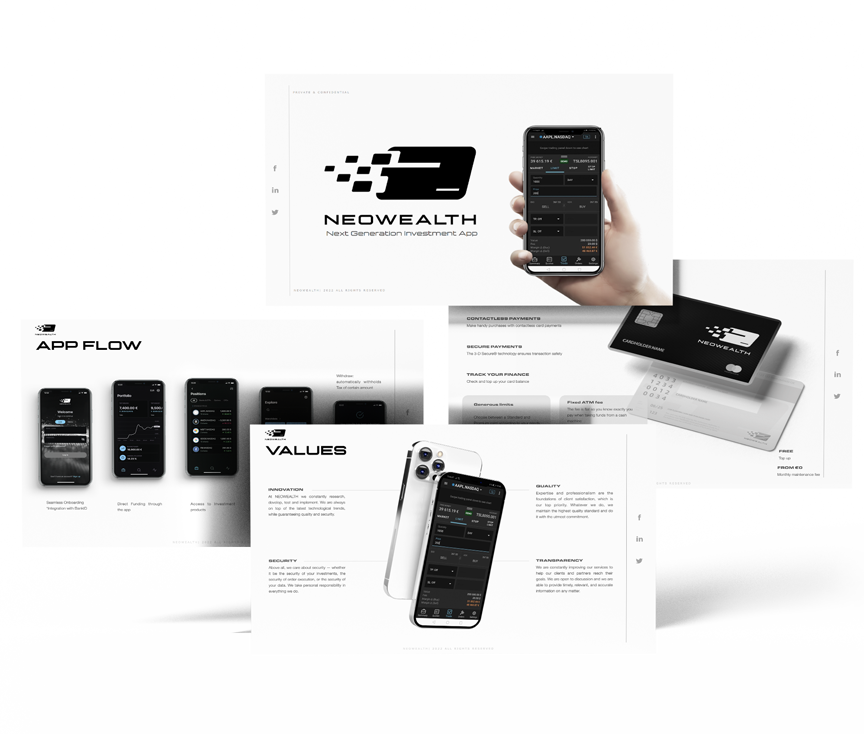How to pitch an app idea to investors

Considering the current saturation of the app market, pitching an app idea and securing funding for development has become increasingly vital, particularly for entrepreneurs and businesses with limited financial resources.
While there are several apps that have enjoyed huge financial success over the years, all that glitz and glamour belie the fact that having a brilliant app idea alone will no longer guarantee secured funding. In fact, that couldn’t be further from reality.
According to statistics, 90% of start-ups failed in 2019. And when you drill down on the numbers, you’ll find 21.5% of start-ups fail in the first year and 30% in the second year.
One of the most prevalent reasons for failure? Money running out.
This highlights the importance of finding angel investors who will trust an app idea enough to invest in it – specifically, securing pre-seed funding ranging around $100,000 in exchange for 10% to 25% of shares.
How important is app funding?
To secure funding for your app, you need to know how to pitch your idea and demonstrate its ability to succeed in the marketplace. But before that, you need to take a step back and understand why your project needs funding in the first place.
People of different backgrounds often approach project development from different angles.
Co-founders who are programmers and developers are often caught laser-focused on the app development aspect of a project, neglecting the business side of things in the process. Meanwhile,
co-founders who come from a marketing background have a habit of obsessing with the scalability of a business, consequently overlooking app dev potholes that could add up to more costs later.
In both scenarios, secured funding is paramount to navigate potential users towards discovering the app and getting them to hit download and pay for it. Funds are also needed for further R&D and to provide high quality customer service.
This is the pain point of most app-based businesses – being unable to invigorate their business application with real revenue and scaling up across all the relevant target markets.

App Funding Channels
There are various ways to get funded. Here are some ways you can get funding into your project:
Family and friends. The first possible source of funds is your friends and family, who are most likely the easiest to convince that your app is worth it. However, typically your connections can only sponsor at the initial stage of the project. To further expand the business, you need to consider other types of investors or funding sources.
Co-founders. If you believe you can pitch your idea outside of your inner personal circle, you can also consider looking to partner with a co-founder who can help support your project financially – whether directly, through networking and connections, or both.
App contests. Another way to tap into funding sources is to participate in several app contests. Consequently, this will give you a chance to present your app idea to potential investors and convince them to finance your project.
Crowdfunding. Crowdfunding is a way to raise capital through incremental investments from a large number of individuals or investors through crowdfunding platforms. The idea is to pool small funding amounts from a wide variety of sources in order to achieve the large investment needed to push the project forward. With crowdfunding, you will need to invest time, effort, and probably money in marketing to make your crowdfunding campaign successful.
Angel investors and venture capitalists. These types of investors are the ones you should look for if you are looking for entities capable of investing a large sum of money to fuel your start-up. Angel investors are more often individuals, while capitalists are usually companies.
Depending on your app idea, funds needed, and the stage you are at, you’ll need to source funding in different places and pitch your project in different ways.
Securing funding comes down to pitching the “idea” behind your project – something that many entrepreneurs will have to do successfully to get buy-in from investors.
Pitching an App: Points to Consider
1. Profile Research
Although nobody is expecting that you’re an expert in each field of business, you need to be mindful of the background of the people to whom you will present your idea. The pitch needs to be tailored to deliver an appropriate “message” that would answer the fundamental questions of whoever is listening, whether it’s the financial team, marketing team, developers, or the investors.
To illustrate, if your background is finance, but you need to pitch an app to an angel investor with a tech background, make sure to get the tech support you need for your pitch to cover all the business aspects. If you will use the funding to get the right people on board, be honest and describe the actual business situation in your pitch.

For investors to be interested in your app, you have to make your pitch custom-made for the type of investor and make a compelling argument to prove why your idea is worth the investment.
2. Psychology & Mindset
When making an investment pitch, it’s important to understand how a potential investor can see value in the project you are bringing to the table. Step into their shoes and see things from their perspective.
Forget how emotionally connected you are with a project. When an investor comes forward with an interjection that pushes back on your idea, take it for what it is: an objective take on your proposition, from an outsider’s perspective. You are there for a reason – your success is their success, but the same goes for losses. So understand that your investor is simply trying to test out the market fit of your project and gauge its potential for success.

It is up to you to deliver a pitch that clarifies all their queries, and at the same time, inspires confidence in the project. That includes understanding how you can placate the risk concerns of potential investors. If you ever come across a question or statement that you find challenging, take notes. Critical junctions such as these can help you prepare better in future pitches.
Accept criticism, especially from people who can provide you valuable insight based on experience. Similarly, be ready to accept rejection at every turn. Remember: not even the most successful businesses today managed to secure funds right off the bat. For instance, start-up AppMaker contacted 173 different investors but only managed to get 14 out of them.
3. Preparation
One of the first things that investors will heavily consider before they invest in a project is YOU – the founder. You will be under scrutiny the moment you walk through the door. So be confident and show your audience that you know your business idea to heart. After all, your job is to convince your audience that you have what it takes to execute your vision.
You need to be likable, as you are a significant part of the project you seek investment for. You can start earning their confidence by being 10-15 minutes early. Always bring back-up in case of technical issues. Make sure you charge your device, and ensure your prototype is readily available to be accessed and shared. Review and practice your presentation. Finally, wear an outfit fitting for the occasion.

Looking your best for an important meeting can help immensely in sending the right message to potential investors. And while these small things are not necessarily what will get investors to buy in to your idea, they are aspects that will help convince them to hear you out in the first place.
In a way, a pitch is similar to a first impression. Either you make it right, or you don’t. Every investor has reasons to invest and not to invest. If investors think you’re a winner, they focus on the former, and if not, they focus on the latter. It’s up to you to get them leaning one way instead of the other by making that first impression count.
4. Prototyping

Consequently, preparing a prototype of your app will place your brand ahead of the competition. It is concrete evidence of the feasibility of your idea.
As the app market grows, convincing investors that your idea will revolutionize the market without seeing how it functions will be challenging. Consequently, preparing a prototype of your app will place your brand ahead of the competition. It is concrete evidence of the feasibility of your idea.
You can hire an app development company to create the app prototype if you have funds. If you don’t have funding to hire developers, you can apply UI kits to enable you to drag and drop design elements. By doing so, you can present your app’s simple touch and feel, which will be benefit your pitch. Additionally, a prototype can help provide strong visual cues to support you in your presentation.
5. Pitch Deck
A solid pitch deck is essential to any investor meeting. A good pitch deck will guide your investors through your idea for the project, as you make your presentation.
As such, use simple words that your audience can easily understand. Keep your sentences short, so your audience can easily digest and remember your key points. Focus on the key points, provide hard facts and realistic estimations. When it comes to the length of your presentation, limit your deck to 10-15 slides, with the cover showing relevant graphics and your brand slogan, indicating what your project is all about.
The design of your slides should be viewer-friendly, which means avoiding text blocks that would dissuade the reader from paying attention to you and your pitch. Use fonts that are easily readable and accurate visuals that support the points you intend to highlight. Design-wise, keep it well balanced and simple. And when applicable, use mock-ups to visualise what the app could look like in real-world application.

A good pitch deck will guide your investors through your idea for the project, as you make your presentation.
You have to remember that investors like venture capitalists see many pitches daily and only have limited time for each pitch. It would be best to take advantage of this by making your presentation captivating right off the bat. To make that happen, you need to bear in mind the basic structure of a pitch. Here’s what a sample structure of a pitch deck should look like, which should come in the form of a table of contents:
- I. Cover
- II. Executive Summary
- III. Problem
- IV. Solution
- V. Market Opportunity, Competition, Target Market, & Audience
- VI. Product
- VII. Team
- VIII. Financials
- IX. Roadmap
- • Cover. The first thing you need to keep in mind is your business idea and how you will present it to your audience. Upon seeing your pitch cover with a few words’ explanation, your audience should know entirely what the business is all about. Remember, the people who will not get your idea at first will be harder to convince with time. It is not easy to describe a complex project in a few and simplified words. However, this will also serve as an opportunity to showcase your knowledge and exhibit your expertise in the business. Elements to include in your cover:
- o Related, good quality teaser picture
- o Company logo/name
- o Slogan (Should be short, easy to understand, and describe the core of your project)
- o Contact and date (to not look outdated, use the year instead of full date either on the cover or the last slide)
- o Make sure you add the following at the bottom: “Confidential and Proprietary. Copyright © by [Name of Company]. All Rights Reserved.”
- • Executive Summary. The next slide is a short executive summary to give the investors a brief insight into your pitch’s key details. It’s a synopsis of your answers to important questions such as: what you offer, why it is needed, how you will market it, and who are your targeted users. In some cases, you can include key points such as investment highlights in the executive summary. However, for a more detailed discussion on the investment required for the project, you could either discuss the details in the financials section or create a dedicated investment page later on.
- • Problem. The problem statement is an important thing to include in your pitch. You need to show your audience that the problem exists and that your application can solve it. The problem should be significant and explained in a manner that the audience can relate to. Use a relatable and typical example that investors could easily understand. If the problem was recognized earlier and existing apps are trying to address it, explain the differentiation of your brand. Maybe existing apps lack some features, and your app can do better, or perhaps it’s not yet in your target location, which could prove a chance for your idea to succeed. While some of the audience may hear your pitch for the first time, others could have a chance to get your pitch sent earlier, and they could get prepared for the meeting. That is why you must know the space your project is related to. To identify the problem your app solves, craft an elevator pitch: a short statement that hooks a listener when it takes to ride an elevator, usually around 20-30 seconds.
- • Solution. Once you identify that a problem exists, the next step is to present solutions on how your app could address it. The best way is to offer conclusive judgment on how you will fix or minimize the existing problem. Here, you can use a fictional prototype by including screenshots or demos to illustrate how you will use the app and make your presentation more appealing. Keep your solution straightforward and comprehensible.
- • Market Opportunity, Competition, Target Market, and Audience. It is a crucial part of your pitch as you need to show the demand for your app. Keep it short, bold, and straight to the point. Do your research and include valuable data about your market size and growth and narrow your data to a specific industry. For instance, if you are pitching for a gaming app, you may show the growing trends by comparing the number of gaming app users to date with the previous years. You may also include the estimated size of the gaming app industry and its potential value. Lastly, keep your data updated, accurate and provide the links to your sources. Only use reliable sources like McKinsey and Statista, and avoid using Wikipedia.

-
The Product slide of the pitch deck should describe your mobile app and why it’s unique.
- • Product. The Product slide of the pitch deck should describe your mobile app and why it’s unique. Use images, visuals, and videos to present your product. Another essential tip to follow is while the idea can be broad, you need to communicate your MVP with the thought in your mind – crawl before you walk. Don’t try to be everything for everybody as you may look unrealistic. By far, companies with sustainable steps and repeat business models are poised for exponential growth and are investors’ favourite picks.
- • Team. If you feel you have a strong team with recognisable and respected individuals, you can have a dedicated team slide to strengthen your pitch deck. Highlight the experience and background of the core individuals leading the project to reassure investors that you have a dedicated team with the expertise to grow the company significantly.
- • Financials. Your financials will be key in convincing investors that your project is worth the funding that will be put into it. Investors will expect to see data such as your sales forecast, income statement or cash flow forecast for at least the next three to five years, and get an understanding of the underlying assumptions. Your financials slide should also be able to tell them about: o Monetisation strategy: How is your business going to create value and generate profit? What are its core income streams? Your financials slide should accurately cover these business aspects in detail.
- o Start-up costs: These include one-time payments like the price of app development and operating expenses such as office rent and employee salaries.
- o Funding: Your financials slide should clearly lay out the amount of funding you intend to secure, the manner in which it will be spent, and at what pace.
- o Return on Investment (ROI): ROI is one of the most important factors investors consider when making a decision. Your Return on Investment (ROI) predictions should be based on your business model.
- • Roadmap. For a strong finish to your pitch deck, have a roadmap slide ready to show potential investors that you have a long-term vision and plan for your app. Your roadmap should display a timeline and clear milestones to be achieved that reflect the business goals you have incorporated in your project. Not only does this show that you have an intended path to profitability or monetisation – which is a key aspect for investor buy-in – but it also reveals your ideas for further development of the project, leading to greater market capture.
Final Thoughts
At the core of it all, you should be able to demonstrate how your app will succeed in the marketplace and what kind of return investors can expect once they invest. Research on your potential investors and find a strong common ground, where you can connect your project with their interests or passions. Get into the right mindset and try to align yourself psychologically with the thought process of your audience.
Come to the meeting well-prepared and present yourself and your app project with confidence, as investors will use that as a gauge of your ability to drive the project forward. Prep a prototype of the app to allow investors a first look at the product and its potential. Finally, create a pitch deck that can provide sufficient visual support for you, as you go through investor meetings.
If you can successfully bring together all the above and meet with the right people at the right time, you give yourself the best chance of landing an investor and securing funding for your app project.


